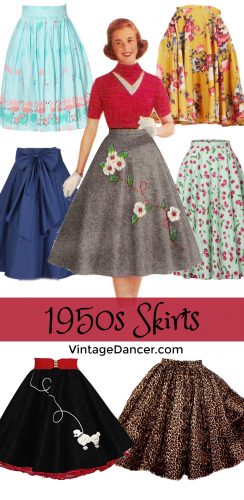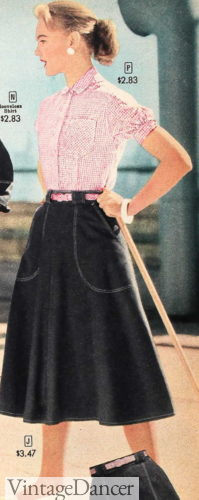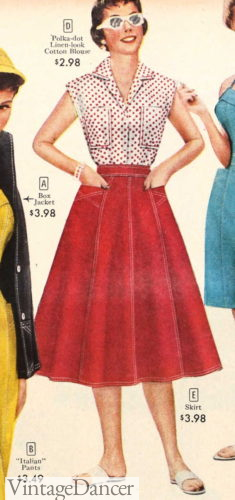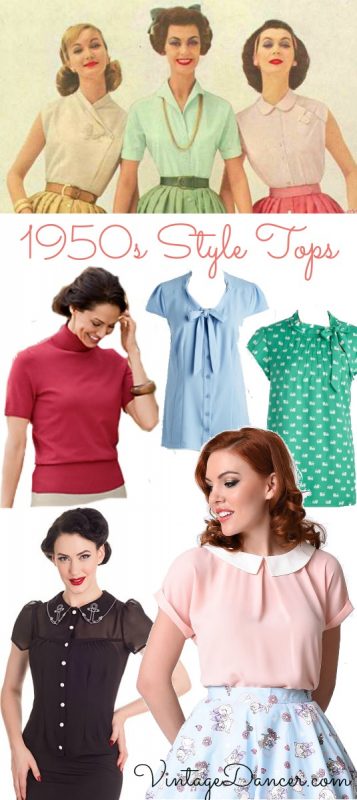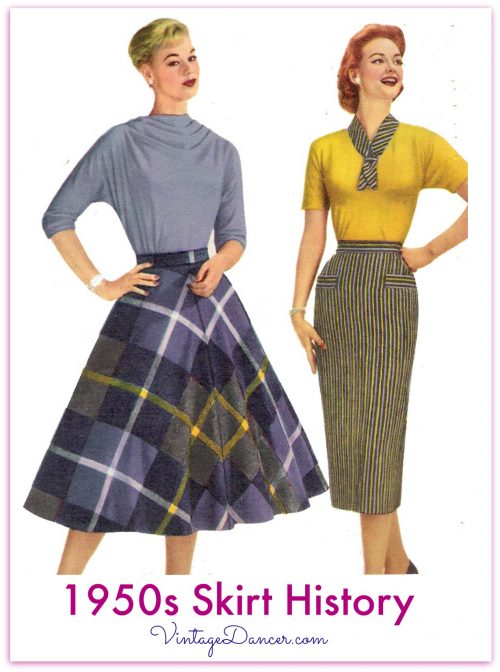
The New Look shape of 1947 carried over into women’s 1950s skirt styles. Skirts were tight at the natural waist and were either very full or very fitted. The names of these style of skirts have changed over the decades.
Today, 50s skirts are often called full circle skirts, swing skirts, pencil skirts, wiggle skirts, tea length skirts, or midi skirts. They are very figure flattering and fun to wear, which is why 1950s skirts are must-have items in any vintage fashion lover’s wardrobe.
What kind of skirts were popular in the 50s? Let us explore the many variations of ‘50s skirts with a bit of social history mixed in.
Start shopping for 1950s style skirts here.
1950s Swing Skirts
The fuller the skirt, the better in the 1950s! With the aid of multiple layers of stiff petticoats and a possibly a hoop skirt, ’50s skirts were as voluminous as the wearer could make them. The skirt was often 4 or 5 yards of fabric draped using a few different techniques.
These 1950s skirts usually started with a 3 inch wide waistband at just above the natural waist. The band fastened on the side or back with a zipper and button.
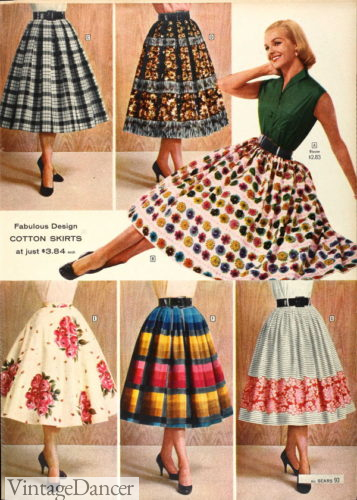
1958 plaid, floral, all over and border print skirts
In order to get the most fullness with the neatest gathers, the fabric of choice was cotton broadcloth in a range of pastel solid colors (pink, lavender, turquoise), all over prints, border prints or big plaids. These fun colors and prints made wearing them a joy.
The prints were quite unique with representations of travel, nature, atomic art, folk wear, western motifs, tribal themes, polka dots and so much more.
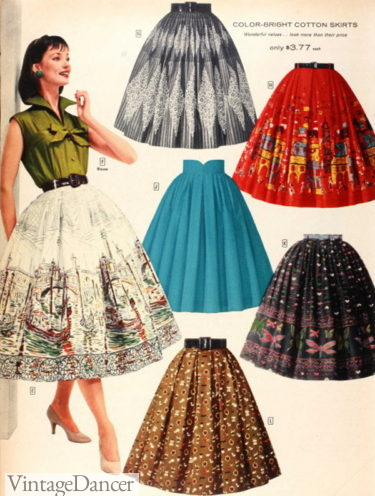
1957 swing skirts, bright prints
To be really in fashion in winter, the skirt had to be made out of wool. Extremely heavy and difficult to keep full even with hoops AND petticoat underneath, they were only for the bravest of women or those willing to wear them without a stiff petticoat. Large box pleats helped create fulness without excess weight.
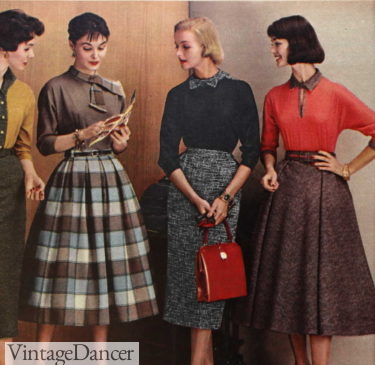
1957 wool skirts with skinny belts
The full skirt was popular because it was flattering. The fullness hid big hips and made waists look smaller. The fuller the skirt, the more magic it had on slimming waistlines.
Adding a wide cinch belt over the skirt band created an even more “wasp waist” look. Leather and plastic cinch belts were very popular, but they were prone to tearing and bunching up blouses. The elastic cinch belt was the best at both keeping blouses tucked and waists thin.
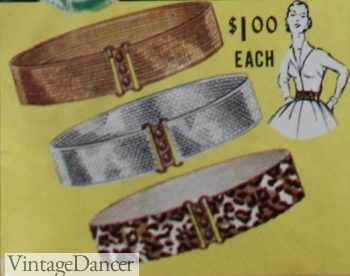
1958 Elastic Cinch Belts
Skinny belts were also worn with pencil and circle skirts. The belt loops sat in the middle of the waistband.
1950s skirts came in long or mid shin lengths. As the decade moved form the 1940s to the 1960s the hemline of skirts also moved up. Midi length skirts were the most popular for lounging at home or in formal wear settings. The below knee length was the most common length for anything from housework to dancing.
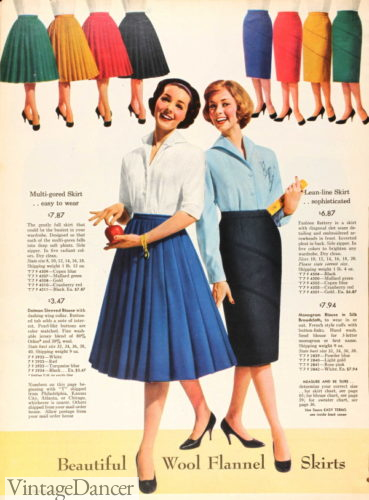
1959 knee length full and pencil skirts
1950s Swing Skirt Styles
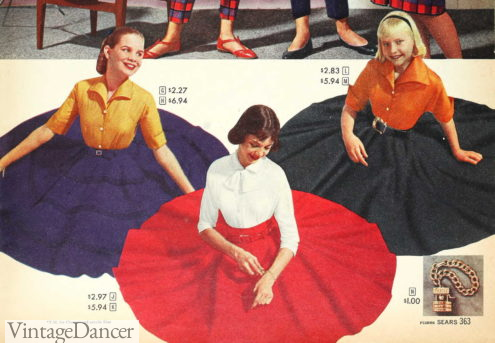
1959 teen girls circle skirts
The 1950s circle skirt was the least bulky of the full skirts. The pattern was cut from one very large square piece in the shape of a doughnut. The inside circle was the waist measurement and the outside circle created the fullness. The skirts hang beautifully in drapes that swing with movement. You can understand why they were so popular with the teen dancing set. They are also very easy to make.
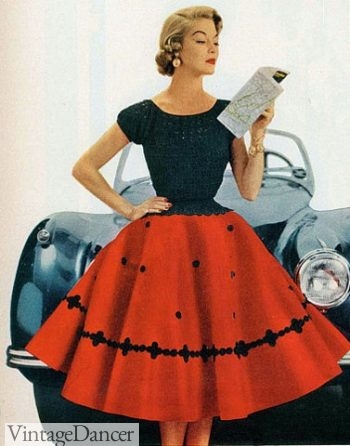
Another 1950s Felt Skirt with polka dot abstract design
While cotton and wool were used in circle skirts, wool felt was the best choice. It was thick yet light, which made it cover hoop skirt ridges easily. It also didn’t need hemming, since the edges never unraveled. Add some rick rack and the skirt was really styling! In the age of “atomic” art, abstract designs circled the skirt hem such as these below.
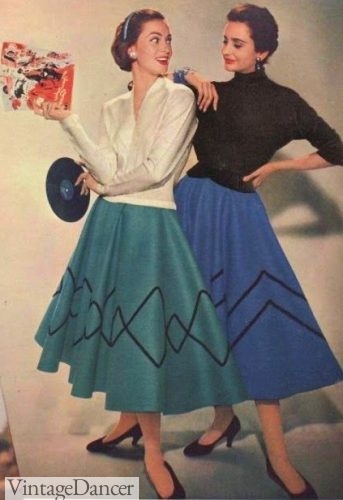
1955 Felt Skirts decorated with a geometric design rather then a poodle or other character
50s Poodle Skirts
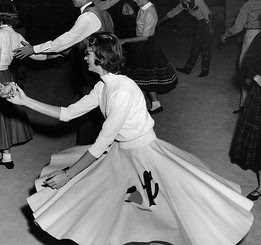
Dancing in a poodle skirt
The 1950s poodle skirt was a ‘50s favorite swing style with a poodle standing at the hem of the skirt, complete with a curly embroidered or sequin leash. Other decorations came in the form of the large applique cats, scotty dogs, butterflies, guitars, clowns, music notes, toys, or catchy phrases like “See You Later Alligator.”
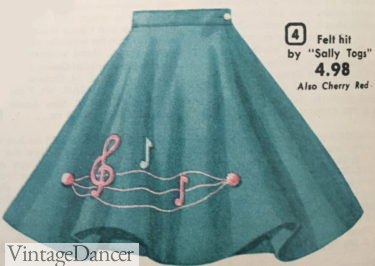
1952 music themed poodle skirt
They were made of wool felt, just like circle skirts (because they were circle skirts.) The poodle skirt became a lasting icon of the 1950s especially for girls and young teenagers, but women wore them, too, with more mature appliques such as the Eiffel tower, telephone, and martini pictured below.
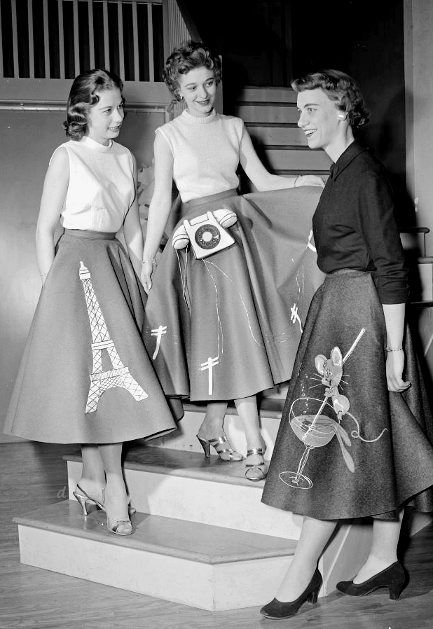
Poodle Skirts were not Just for Teens
Poodle skirts were paired with a sweater tops or button-down blouses, white bobby socks and saddle shoes- the same ionic look worn to Sock Hop dances. Learn more about the origins of the Poodle Skirt or shop poodle skirts here with even more poodle skirt history.
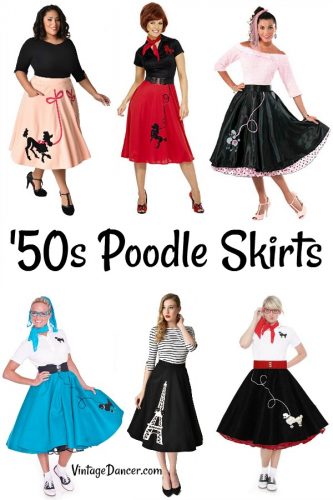
Shop ’50s poodle skirts and poodle skirt costumes
1950s Skirt Styles
Gathered skirts:
A 1950s gathered skirt was made from a giant rectangular piece of fabric that was gathered in at a waistband so that it was fitted at the waist and full at the bottom. They were especially becoming on women without much natural hip since the bulky band gave instant curves. The shape rendered itself to be more A-line with the fullness at the hem instead of around the hip.
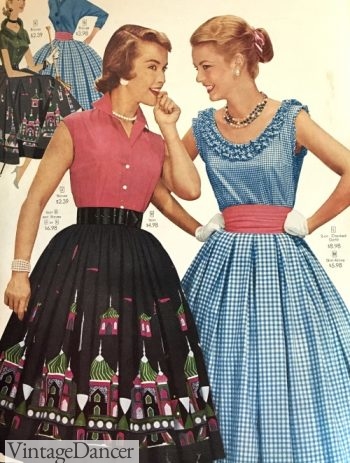
1956- A Gathered Skirt (left) creates fullness around the hip. A wide cinch belt brings in the waist. The Pleated Skirt on the right has less bulk at the hip but ample fullness at the hem.
Button up skirts were gathered skirt with a button front, similar to a shirtwaist dress, running down the center front. They were usually plain color with white buttons.
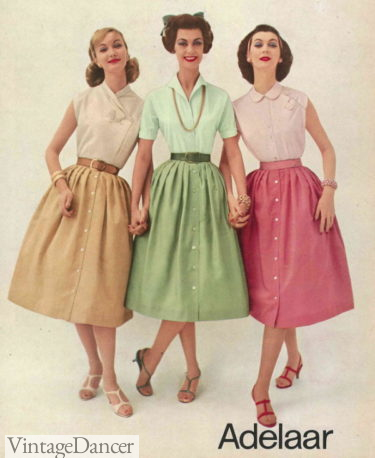
Button-down skirt
Button down skirt worn over shorts or rompers were called playsuits. More about those here. In the evenings, a long or short button down skirt or dress worn over capri pants became a hostess dress. Read about those too.
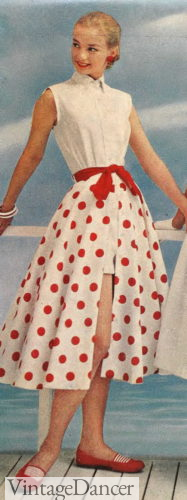
1957 playsuit skirt over a romper
Pleated skirts were also popular in the ‘50s, especially with Dior. They could be large pleats or tiny accordion ones, as long as there was plenty of fabric! Plaid was the most popular pint for a pleated skirt. Some were even reversible with two solid and plain on either side.
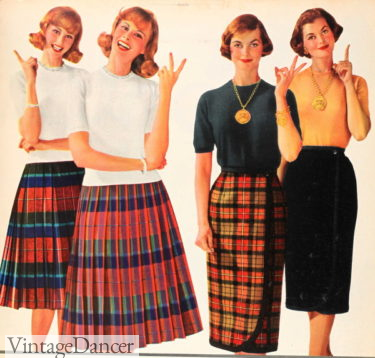
1959 reversible pleated skirts and pencil skirts
Gored skirts featured panels of triangles sewn together with the points coming into the waistband, once again making the skirt much wider at the bottom. They were best when made with heavy fabric such as denim or wool.
- 1957 denim skirt (two-four panels)
- 1955 gored red denim skirt (either panels)
Lastly, tiered skirts, made from layers of gathered fabric that got wider and wider towards the bottom, allowed for fullness and added a peasant flair to the look. Tiered skirts were usually gathered at the top, but had more flounce than a regular gathered skirt.

1960 Dirndl tiered skirt with corset waistband
They were a style that came from the big trend for all things Western, Latin and folk art. 1940s had similar peasant skirts called Dirndl, inspired by German folk fashion.
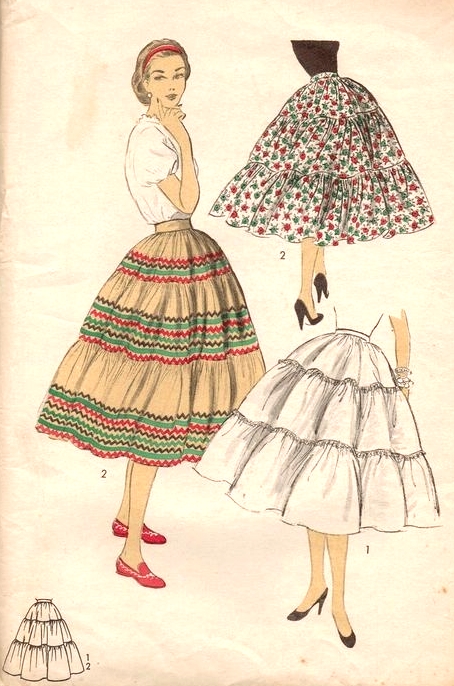
1950s Tiered Skirts
Within these basic circle skirt constructions are even more variations. This 1952 article in McCall’s magazine described the various skirt patterns they sold (from top left):
Gathered all around except a flat front panel, high rising with bracket-shaped pockets, slim with pleats to round the hips above the flapped pockets, with a waist-cincher over a four-gored skirt, work skirt wrapped and tied with accordion pockets, flat over hips with set in panels, and straight with arched pockets.
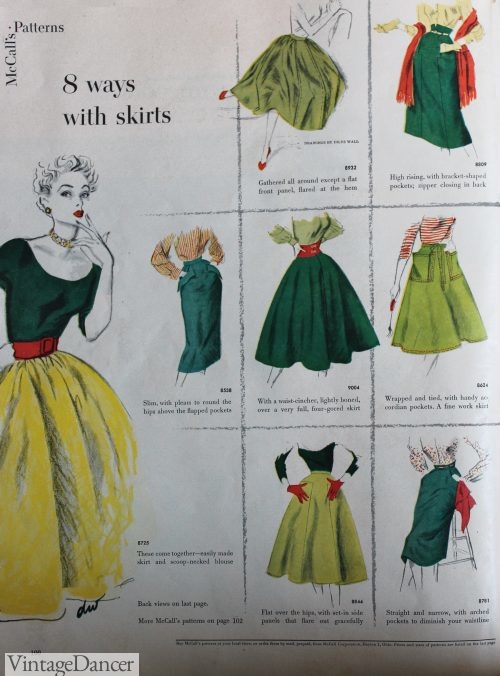
1952 McCall’s Skirt Types
1950s Pencil Skirts
1950s fashion was a time of opposites and nothing makes that point as much as the drastic difference between full and sheath skirts. Fitted sheath skirts were called hobble or pencil skirts during the ‘50s because they were tight enough that they were difficult to walk in. For this same reason, pencil skirts also called wiggle skirts today, although the modern fit is snug to curves and the vintage 50s fit was straight from hip to knee.
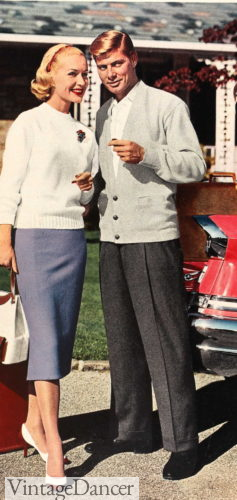
1958 pencil skirt and sweater top
Short pencil skirts that ended at the knee were a bit easier to walk in. Mid shin length skirts were harder but more common. Some had a back vent or kick-pleat up the thigh to allow for movement. Some longer skirts only had a decorative kick pleat that went up to the knee– a useless ornament.
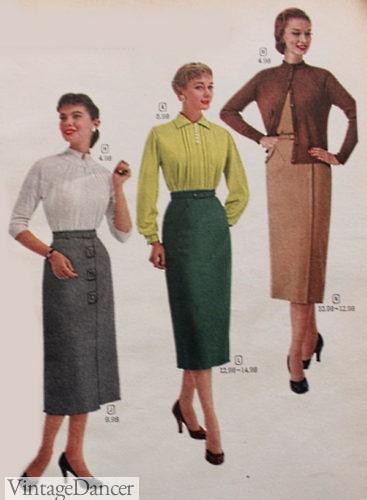
1951 wool pencil skirts for winter
Sheath skirts started with a waistband at the natural waist and curved tightly over the hips and then tapered down the legs just below the knee or a bit longer. The straighter the fit, the better for most of the ’50s. The later part of the decade favored a rounded, fuller hip, that often required models to wear hip pads to achieve the perfect silhouette.
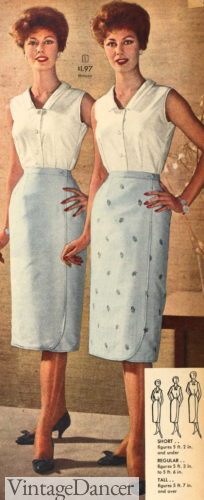
1959 nipped waist and full hip wrap pencil skirts
For women with naturally round hips, the sheath skirt was perfect. What was hidden in full skirts was revealed in pencil skirts. They were sexy, especially when they were worn with a pair of high heel pumps. Together they made a woman wiggle her walk, hence the common name now: wiggle skirts.
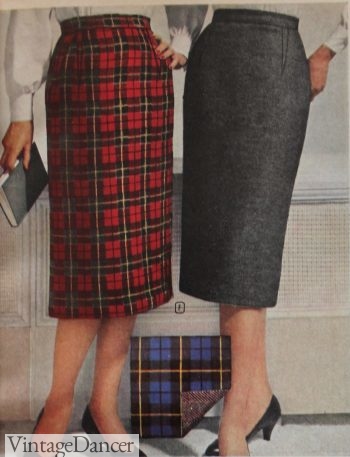
1959 Pencil Skirts in Solid and Plaid
Fitted 1950s skirts were usually plain colors or in a plaid or houndstooth pattern. They also sometimes had decorative buttons down the center or on one side or had large patch pockets on the front. They were a style of skirt for the mature women.
Teens were encouraged to stay clear of the sheath skirt– they were too sexy for “children.” Of course, teens didn’t pay attention to those rules and wore sheath skirts anyway. They felt so sophisticated in them.
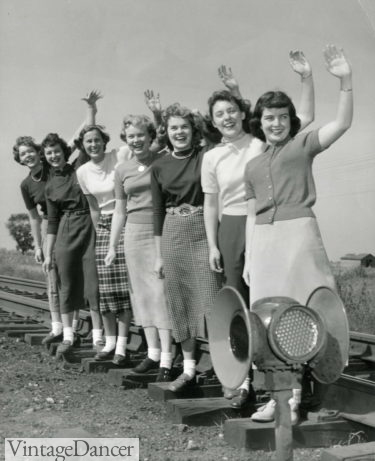
Teen wearing midi sheath skirts
Pencil skirts were not very good for dancing, except while doing the twist. Latin inspired fringe skirts were a short lived fad. They were fun to dance in but impractical for most other occasions.
Another short lived variation of the of pencil skirt is what we call a mermaid or fishtail skirt. The bottom 1/3 featured a gathered ruffle or pleated hem.
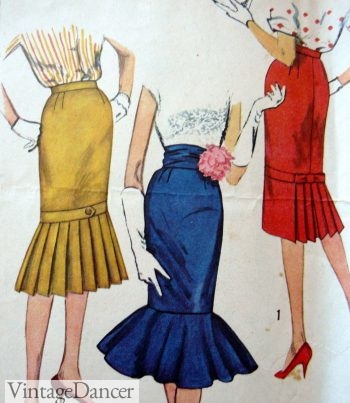
1950s Fishtail Skirts
What to wear with a skirt?
Pairing the right 50s top with either a swing or pencil skirt is critical to creating the best outfit. Some common tops were:
- Blouses- short, long or sleeveless button down blouses tucked into skirt waistband
- Knit shirts- Dolman sleeves, short sleeve knit tops, striped or plain T-shirt, polo shirts
- Sweaters- Twin sets sweaters
- Peasant tops – Ruffled peasant tops with swing or tiered skirts
- Halter neck tops for summer
- See 1950s outfit ideas
Learn about 1950s tops and 1950s blouses, shirts or sweaters
Shop 1950s Style Skirts here
Shop these 1950s inspired full circle skirts and pencil skirts from multiple retailers online. Add a wide cinch belt to create that ideal 1950s wasp waist. Or if you prefer to make your own, there are some 1950s skirt patterns available, too.
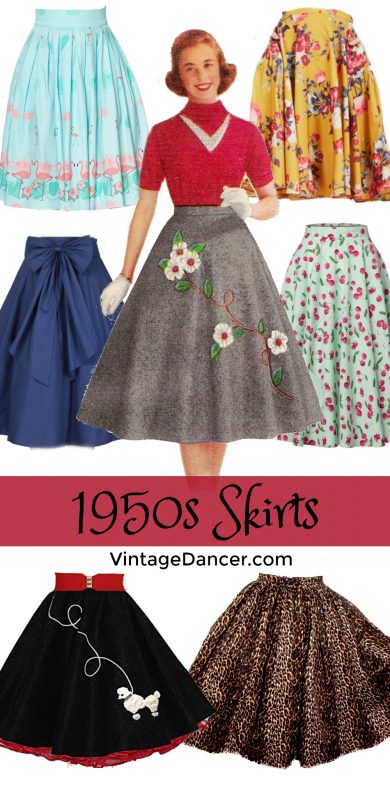
1950s skirts, swing skirts, circle skirts, poodle skirts for sale. Shop now.
Debbie Sessions has been teaching fashion history and helping people dress for vintage themed events since 2009. She has turned a hobby into VintageDancer.com with hundreds of well researched articles and hand picked links to vintage inspired clothing online. She aims to make dressing accurately (or not) an affordable option for all. Oh, and she dances too.
